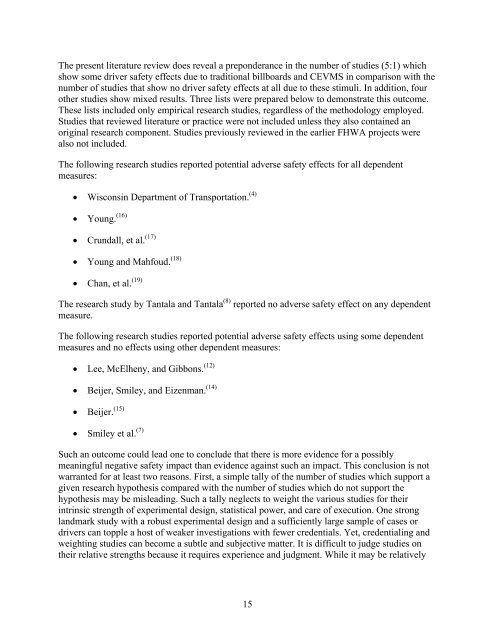The Effects of Commercial Electronic Variable Message Signs ...
The Effects of Commercial Electronic Variable Message Signs ...
The Effects of Commercial Electronic Variable Message Signs ...
You also want an ePaper? Increase the reach of your titles
YUMPU automatically turns print PDFs into web optimized ePapers that Google loves.
<strong>The</strong> present literature review does reveal a preponderance in the number <strong>of</strong> studies (5:1) which<br />
show some driver safety effects due to traditional billboards and CEVMS in comparison with the<br />
number <strong>of</strong> studies that show no driver safety effects at all due to these stimuli. In addition, four<br />
other studies show mixed results. Three lists were prepared below to demonstrate this outcome.<br />
<strong>The</strong>se lists included only empirical research studies, regardless <strong>of</strong> the methodology employed.<br />
Studies that reviewed literature or practice were not included unless they also contained an<br />
original research component. Studies previously reviewed in the earlier FHWA projects were<br />
also not included.<br />
<strong>The</strong> following research studies reported potential adverse safety effects for all dependent<br />
measures:<br />
• Wisconsin Department <strong>of</strong> Transportation. (4)<br />
• Young. (16)<br />
• Crundall, et al. (17)<br />
• Young and Mahfoud. (18)<br />
• Chan, et al. (19)<br />
<strong>The</strong> research study by Tantala and Tantala (8) reported no adverse safety effect on any dependent<br />
measure.<br />
<strong>The</strong> following research studies reported potential adverse safety effects using some dependent<br />
measures and no effects using other dependent measures:<br />
• Lee, McElheny, and Gibbons. (12)<br />
• Beijer, Smiley, and Eizenman. (14)<br />
• Beijer. (15)<br />
• Smiley et al. (7)<br />
Such an outcome could lead one to conclude that there is more evidence for a possibly<br />
meaningful negative safety impact than evidence against such an impact. This conclusion is not<br />
warranted for at least two reasons. First, a simple tally <strong>of</strong> the number <strong>of</strong> studies which support a<br />
given research hypothesis compared with the number <strong>of</strong> studies which do not support the<br />
hypothesis may be misleading. Such a tally neglects to weight the various studies for their<br />
intrinsic strength <strong>of</strong> experimental design, statistical power, and care <strong>of</strong> execution. One strong<br />
landmark study with a robust experimental design and a sufficiently large sample <strong>of</strong> cases or<br />
drivers can topple a host <strong>of</strong> weaker investigations with fewer credentials. Yet, credentialing and<br />
weighting studies can become a subtle and subjective matter. It is difficult to judge studies on<br />
their relative strengths because it requires experience and judgment. While it may be relatively<br />
15

















